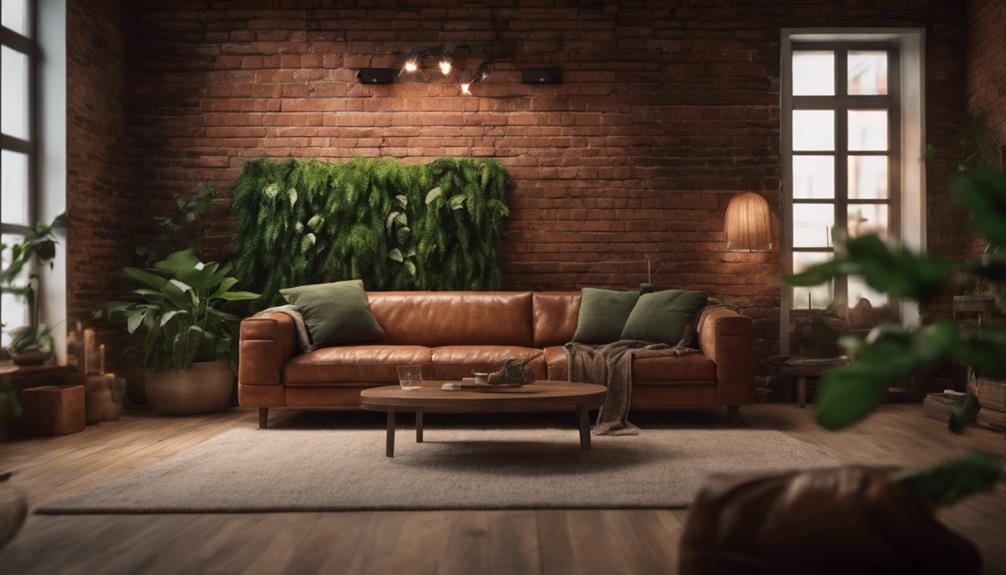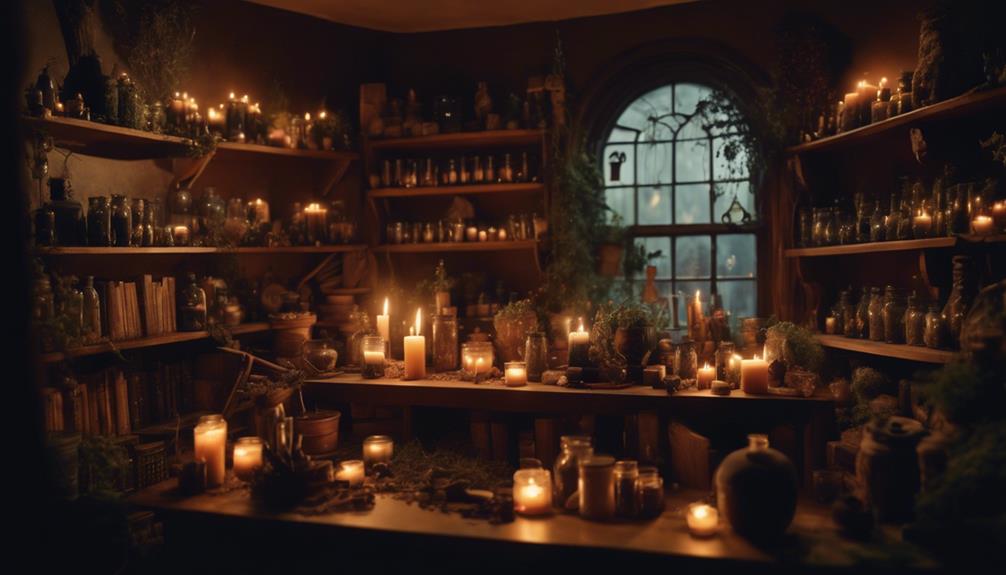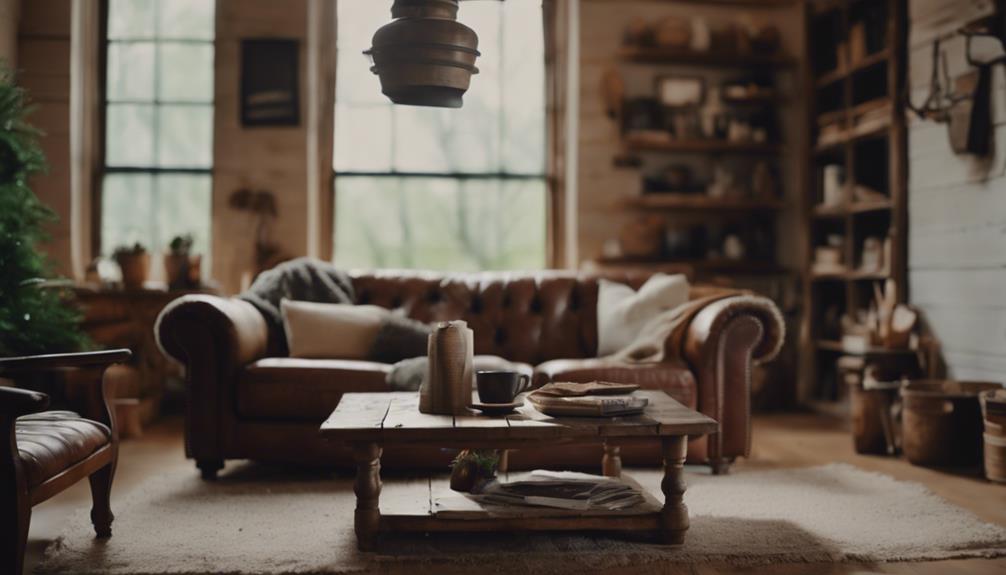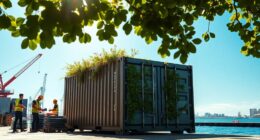Aesthetic wall shelves provide you with stylish storage solutions that brighten up your space and reflect your unique style. You can choose from a range of materials like wood, metal, or acrylic, each offering its own vibe. Mixing colors and textures adds a personal touch while ensuring functionality. Enhance your displays with decorative items like framed art or vintage figurines. Consider lighting options like pendant lights or LED strips to highlight your shelves and create a cozy atmosphere. If you're looking for more tips on maximizing your space, there's plenty more to explore!
Key Elements
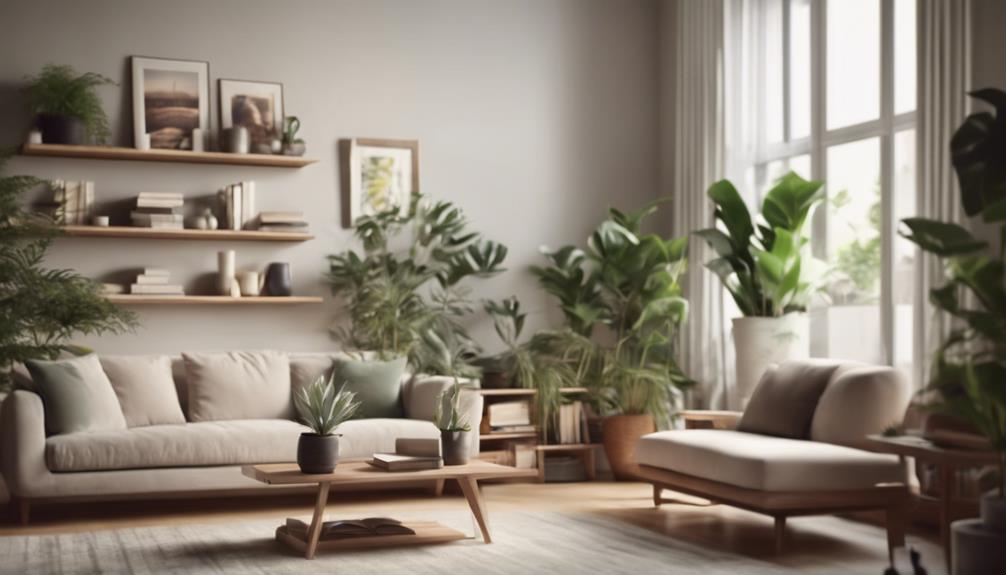
When choosing aesthetic wall shelves, consider the color scheme that complements your space.
The materials and textures also play an essential role in both durability and style.
Color Scheme
Aesthetic wall shelves offer a vibrant palette of colors, allowing you to personalize your space and reflect your unique style. With a wide range of hues available, you can easily find wall shelves that complement your existing decor and align with your preferred interior design aesthetic. Whether you lean toward bold, colorful options or prefer subtle, neutral shades, there's something for everyone.
These shelves not only serve as practical storage solutions but also act as eye-catching decorative elements. You can mix and match colorful wall shelves with brackets in complementary colors, creating a cohesive look that enhances the overall ambiance of your room. Sculptural designs can also be incorporated, adding a dynamic touch to your walls.
When selecting wall shelves, consider how their colors interact with your furniture and other decor elements. A well-thought-out color scheme can transform your space, making it feel more inviting and stylish. By choosing the right colors, you can elevate your interior design while keeping your storage solutions functional and visually appealing.
Embrace the endless possibilities that aesthetic wall shelves provide, and let your creativity shine through!
Materials
Various materials, such as wood, metal, and acrylic, give you plenty of options to choose from when selecting aesthetic wall shelves that suit your style and durability needs.
Wooden shelves, with their natural finishes and textures, bring warmth and character to any space. If you're aiming for an industrial vibe, metal shelves can provide that edgy look while remaining sturdy and functional.
Acrylic shelves, on the other hand, offer a modern, sleek appearance that's perfect for smaller areas; they create an illusion of space without compromising on style. When making your choice, consider how each material greatly impacts both the aesthetic appeal and functional capabilities of the shelves.
For instance, heavier materials like wood and metal usually provide greater stability for storing items, while lighter options like acrylic may be better for decorative purposes.
Additionally, many manufacturers focus on environmental consciousness, utilizing sustainably sourced materials and eco-friendly production processes, so you can feel good about your choices.
Ultimately, your selection will reflect your personal taste while ensuring practicality in your living space.
Textures
Textures are essential in crafting wall shelves, as they can dramatically influence the mood and style of your space. When you choose wall shelves, consider the variety of materials available—wood, metal, and acrylic—all offer unique textures that boost visual interest. Smooth finishes can lend a sleek, modern vibe, while rustic wood grains introduce warmth and character to your room.
Mixing materials creates a striking contrast that enhances your decor. For example, pairing wrought iron with wooden shelves not only adds dimension but also elevates the overall aesthetic. If you prefer a minimalist approach, floating shelves often feature clean lines and subtle textures, making them perfect for contemporary or Scandinavian-inspired interiors.
Don't forget that texture affects functionality, too. Rougher surfaces provide a better grip for decorative items, ensuring they stay in place, while polished finishes offer a refined look that complements upscale designs.
Essential Fixtures and Furniture

When you're setting up your wall shelves, choosing the right fixtures and furniture is key to achieving your desired look.
Consider integrating floating oak shelf brackets for a sleek appearance or a brass wall-mounted storage unit for a touch of elegance.
Don't forget to add a ceramic wall-mounted planter to bring some greenery into your space.
Floating Oak Shelf Bracket
Floating oak shelf brackets offer a stylish and practical solution for displaying your favorite decor while keeping your walls clutter-free. These essential fixtures support floating shelves, lending a sleek and minimalist aesthetic to any room.
Made from high-quality oak, these brackets guarantee durability and stability, allowing you to showcase various decorative and functional items without worry.
You'll find floating oak shelf brackets available in multiple sizes and styles, so you can easily customize them to match your interior design theme and personal preferences.
Installation is straightforward, meaning you can create stylish storage solutions without visible hardware, enhancing the overall look of your space.
Brass Wall-Mounted Storage Unit
Building on the minimalist approach of floating oak shelf brackets, the Brass Wall-Mounted Storage Unit brings both elegance and practicality to your space, making it easy to organize and display your favorite items. Crafted from durable brass, this unit not only adds a touch of sophistication to your decor but also guarantees longevity, making it a smart investment for any room.
Its wall-mounted design is perfect for saving floor space, which is especially beneficial in smaller areas. You'll appreciate how it offers ample storage options without cluttering your environment. Plus, the customizable shelf arrangements allow you to tailor the unit to your personal style and specific storage needs, whether you're showcasing books, decorative pieces, or other essentials.
Ideal for contemporary and mid-century modern interiors, the Brass Wall-Mounted Storage Unit enhances the overall aesthetic of your space. With its sleek lines and polished finish, it effortlessly complements various decor styles while providing a functional solution. You'll find that this stylish storage unit not only organizes your belongings but also elevates the entire look of your home.
Embrace both form and function with this exquisite addition to your wall.
Ceramic Wall-Mounted Planter
Ceramic wall-mounted planters effortlessly blend aesthetic appeal and practicality, allowing you to showcase greenery while saving valuable floor space. These stylish planters enhance your interior decor with their diverse colors and designs, fitting seamlessly into any style, whether contemporary or bohemian.
One of the standout features of these planters is their drainage holes, ensuring proper moisture management for your plants. This helps promote healthy growth while preventing water damage to your walls. You can easily install them at various heights, giving you the flexibility to create eye-catching arrangements that maximize vertical space.
Made from durable ceramic materials, these planters aren't only easy to clean but also built to last, making them a practical choice for both indoor and outdoor use. Their low maintenance needs mean you can enjoy your greenery without the hassle.
Whether you're looking to add a touch of nature to your living room, kitchen, or patio, ceramic wall-mounted planters are the perfect solution. They bring life to your walls while providing a chic storage solution for your favorite plants.
Lighting Ideas

When it comes to lighting your wall shelves, you've got some exciting options to contemplate.
Pendant lights can create a stunning focal point, while wall-mounted LED strip lights add a modern touch.
Track and sconce lighting also offer great ways to highlight your decor and enhance the overall ambiance.
Pendant Lights for Shelves
Pendant lights can dramatically elevate the aesthetic of your wall shelves, highlighting your favorite decor while adding a stylish touch to the room. With various styles available, from minimalistic to industrial and contemporary, you can easily find pendant lights that complement your shelves and overall design theme.
When selecting pendant lights, consider adjustable or dimmable options. This allows you to customize the lighting effects, creating the perfect ambiance while elegantly showcasing your items. You'll find that pendant lights can be installed at different heights above your shelves, providing focused illumination without overwhelming the visual space.
Incorporating pendant lighting with your wall shelves creates a layered lighting effect that enhances both functionality and design. This combination not only showcases decorative pieces but also adds depth to the room, making it feel more inviting.
Wall-Mounted LED Strip Lights
Transform your wall shelves into an enchanting display with wall-mounted LED strip lights, effortlessly adding warmth and style to any space. These versatile lights can be easily installed on or under shelves, creating a cozy ambiance that enhances your decor. With various color temperatures and adjustable brightness, you can customize the lighting effects to perfectly match your mood or occasion.
Installation is a breeze with many LED strip lights featuring an adhesive backing, making them a damage-free option—perfect for renters or anyone wanting a quick decor update. Plus, their energy efficiency means you won't have to worry about high electricity bills; LED strip lights consume considerably less power than traditional lighting options, providing an eco-friendly illumination solution.
For added convenience, consider LED strip lights with smart technology. You can control brightness and color settings directly from your smartphone or via voice commands, making it easier than ever to set the perfect atmosphere. Whether you want a soft glow for relaxation or vibrant colors for a party, wall-mounted LED strip lights are a stylish and functional way to elevate your wall shelves.
Track Lighting for Shelves
Wall-mounted LED strip lights create a cozy atmosphere, but track lighting takes your shelf display to the next level by providing focused illumination that highlights your favorite decor pieces. If you want to enhance the aesthetic appeal of your wall shelves, adjustable track lighting is the perfect solution. You can customize the positioning of the lights to shine directly on specific shelves or decorative elements, ensuring they stand out beautifully.
Opting for LED track lights is a smart choice, as they're energy-efficient and deliver bright, focused illumination without generating excessive heat. This makes them ideal for showcasing delicate decor items that need gentle care. Plus, you'll find track lighting available in various styles and finishes, so you can easily integrate them into your existing design theme—whether it's modern, industrial, or something in between.
Consider installing dimmable track lighting to create versatile ambiance for any occasion. You'll appreciate being able to adjust the brightness according to the time of day or your mood, transforming your space in an instant.
With track lighting, your shelves won't just be functional; they'll be a stunning focal point in your home.
Sconce Lighting for Accent Walls
Sconce lighting frequently enhances accent walls by providing both stylish illumination and a warm atmosphere that highlights your decor. These fixtures offer a blend of functional light and decorative flair, fitting seamlessly into various design styles, from minimalistic to mid-century modern.
With an array of designs and materials available, you can easily personalize sconces to complement your wall shelves and bookcases. When placed strategically, sconces create focal points on your accent walls, drawing attention to artwork or decorative items while adding depth and warmth to the space.
The versatility of sconce lighting makes it suitable for installations in living rooms, bedrooms, and dining areas, enhancing the aesthetics of any room in your home. Consider incorporating dimmable sconces for adjustable lighting levels, allowing you to set the mood and emphasize different features of your accent walls and decor.
Decorative Elements

When you think about decorative elements for your wall shelves, consider incorporating a framed botanical art print, a vintage ceramic figurine, or a handcrafted wooden wall sculpture.
These pieces not only enhance the overall aesthetic but also bring your personal style to life.
Mixing and matching these items can create a visually appealing display that captures attention and sparks conversation.
Framed Botanical Art Print
Framed botanical art prints can instantly elevate the look of your wall shelves, blending nature with stylish design. These prints come in various sizes and frame styles, allowing you to complement different shelf aesthetics, whether you prefer a minimalistic Scandinavian vibe or a more contemporary flair.
Displaying botanical art alongside other decorative items creates eye-catching focal points. The vibrant colors and intricate details of these prints draw attention, making them perfect for enhancing the visual appeal of your shelving arrangements. You'll find that they create a pleasing contrast with materials like wood or metal, adding depth to your decor.
Incorporating framed botanical art into your shelves doesn't just beautify your space; it also evokes a sense of tranquility and connection to nature. This can enrich the overall ambiance of your room, making it feel more inviting.
Plus, these prints can serve as great conversation starters when friends or family visit. So, consider adding a framed botanical print to your wall shelves—it's an easy way to infuse your space with style and personality while celebrating the beauty of the natural world.
Vintage Ceramic Figurine
Vintage ceramic figurines add a touch of charm and character to your wall shelves, making them standout decorative elements in any space. These figurines come in a variety of styles, from whimsical and playful to classic and culturally inspired designs, allowing you to find the perfect accent that complements your interior theme.
The intricate craftsmanship of vintage ceramics showcases fine artistry and reflects the historical significance of the era they represent, making them not just decorative items but also conversation starters. When displayed on your shelves, these figurines can create focal points that draw attention and intrigue your guests.
To maintain their beauty and guarantee longevity, it's crucial to care for your vintage ceramics properly. Avoid placing them in direct sunlight to prevent fading, and use gentle cleaning methods to preserve their intricate details. By taking these precautions, you can enjoy the timeless appeal of your vintage ceramic figurines for years to come.
Incorporating these charming pieces into your wall shelves elevates your decor and adds a personal touch that tells a story, enriching the overall aesthetic of your space.
Handcrafted Wooden Wall Sculpture
Handcrafted wooden wall sculptures bring a unique blend of artistry and functionality to your decor, making them perfect companions to vintage ceramic figurines on your shelves. These pieces aren't just decorative; they enhance the aesthetic appeal of any room while providing practical storage solutions. Crafted from high-quality, sustainably sourced wood, they guarantee durability and longevity, making them a worthwhile investment.
The intricate craftsmanship involved often reflects cultural artistry, transforming each sculpture into a conversation starter. You'll find a diverse range of styles and finishes available, allowing you to personalize your space and match various interior design themes seamlessly. Whether you choose a rustic design or a sleek modern piece, these sculptures add a touch of elegance and creativity.
You can utilize these decorative elements in multiple settings, from homes to offices. They can serve as functional art, holding small items or adding dimension to your walls. With their unique character, handcrafted wooden wall sculptures elevate your decor, assuring your space feels both stylish and inviting.
Flooring

When choosing flooring, consider how different materials can enhance your space.
Reclaimed hardwood adds warmth, while polished concrete offers a sleek, modern vibe.
For practicality, textured vinyl provides easy maintenance without sacrificing style.
Reclaimed Hardwood for Warmth
Reclaimed hardwood flooring brings a unique warmth and character to your space, showcasing its rich history through distinct imperfections and grain patterns. This sustainable option is sourced from salvaged wood, which reduces waste and minimizes your environmental impact. By choosing reclaimed hardwood, you're not only adding beauty to your home but also making an eco-friendly choice.
You'll appreciate the durability of reclaimed hardwood, as it's often denser and harder than new wood. This makes it ideal for high-traffic areas, ensuring your flooring lasts for years. Plus, with a variety of finishes and colors available, reclaimed hardwood can effortlessly complement any interior design style, whether rustic or contemporary.
Another benefit is that reclaimed hardwood typically contains fewer chemicals than newly manufactured flooring products. This contributes to improved indoor air quality, allowing you to breathe easier in your home.
Polished Concrete for Modern Look
Polished concrete flooring provides a sleek, modern look that elevates your space and complements contemporary design. If you're aiming for a minimalist vibe, this flooring option is perfect for you.
It's not just about aesthetics; polished concrete is highly durable and resistant to scratches and stains, making it an ideal choice for high-traffic areas in both residential and commercial spaces.
You'll appreciate the versatility of polished concrete, as it can be customized with various finishes and colors. This allows you to create a unique design that perfectly suits your personal style.
Plus, the reflective surface of polished concrete enhances lighting in your space, making rooms feel brighter and more spacious.
If sustainability is important to you, you'll be glad to know that environmentally friendly options exist. Polished concrete can be made from recycled materials, which reduces the need for additional flooring products and lessens your environmental impact.
With all these benefits, polished concrete flooring stands out as a stylish and functional choice for anyone looking to achieve a modern look in their home or office.
Textured Vinyl for Easy Maintenance
If you're looking for a flooring option that combines style with low maintenance, textured vinyl is an excellent choice that mimics the beauty of natural materials. This durable flooring solution is resistant to scratches and stains, making it perfect for high-traffic areas in your home. You can enjoy the elegant look of wood or stone without worrying about the upkeep typically required for these materials.
Cleaning textured vinyl is a breeze. Regular sweeping and the occasional damp mop are all you need to keep it looking great. Plus, the variety of designs and colors available means you can easily express your personal style while enhancing your space.
Another bonus? Many textured vinyl options are eco-friendly, utilizing recycled materials that contribute to sustainable flooring solutions. By choosing textured vinyl, you not only create a stylish environment but also make a responsible choice for the planet.
Incorporating textured vinyl flooring into your home guarantees you get the aesthetic appeal you desire without the hassle of high maintenance. It's an ideal solution for anyone who values both beauty and practicality in their flooring choices.
Conclusion
Incorporating aesthetic wall shelves into your space not only enhances style but also offers practical storage solutions.
By thoughtfully selecting essential fixtures, lighting, and decorative elements, you can create a harmonious environment that reflects your personality.
Don't forget to think about the flooring, as it plays a vital role in tying everything together.
So, go ahead and transform your walls into a chic display that's both functional and visually appealing—your home deserves it!



